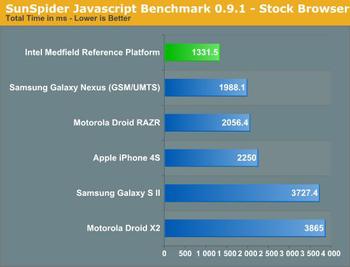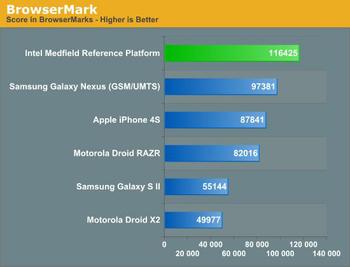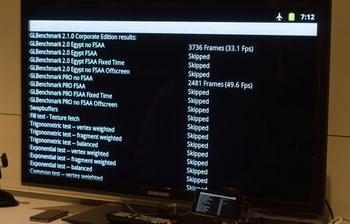We had reported on Intel's plans to exhibit the Medfield SoC at CES earlier this month, with LG to produce a reference design, however what we didn't see coming was the immediate adoption of the new mobile-friendly Atom Z2460 chip by firms Lenovo and Motorola, who, according to Intel, are expected to launch new Medfield devices before July and during the second-half of the year respectively.
We had taken for granted, that given the inclusion of integrated graphics cores in the firm's latest processors, that the on-board core would be of Intel design, however it turns out that like many mobile chips currently on the market, Medfield will contain an Imagination Technologies PowerVR SGX 540 400MHz GPU, with Intel also opting in for Imagination Technologies help for the SoC's video encode and decode capabilities. Though Intel's integrated graphics technology has come a long way, it clearly wasn't ready for the mobile stage.
What has impressed is the power efficiency and performance that this marriage of components has brought about, with Intel announcing that, despite earlier claims, the SoC will consume no more than 800mW in the worst-case-scenario at 1.6GHz in 'Burst Mode', with the chip capable of scaling down to 500mW at 1.3GHz, 175mW at 600MHz and all the way down to 50mW at 100MHz, "Battery life on the platform is not the best in the mobile market, but it is by far not the worst ... We are very effective and good at some tasks and sort of in the middle of the pack at others." stated Mike Bell, Intel's Ultra Mobility Group general manager.
| Intel Measured Smartphone Power Consumption (Identical Display Brightness) | ||||||
| Standby (3G) | Talk (3G) | Browsing (3G) | Video Playback 720p | |||
| Apple iPhone 4S | ~38mW | ~800mW | ~1.3W | ~500mW | ||
| Intel Medfield Reference | ~18mW | ~700mW | ~1.0W | ~850mW | ||
| Samsung Galaxy S II | ~19mW | ~675mW | ~1.2W | ~650mW | ||
The chip is designed to handle an 8 to 24MP primary camera, with support for a 2MP secondary camera, with the device capable of 10-frame burst capture of a full 8MP at 15FPS, thanks to the recently acquired Silicon HIVE ISP technology.
Figures show excellent performance in CPU heavy tasks such as web-browsing, though graphical performance lacks somewhat with the antiquated SGX 540 core; Intel has promised, however, that it will be releasing a Medfield core integrating the SGX 543MP2 before the end of the year, though we'd hope instead to see the PowerVR G6400 in action instead.
Analysts expect the chip to cost around $17 or $18, directly competing with the likes of NVIDIA's Tegra 3. Whilst in some areas, the Atom Z2460 has excellent power consumption and CPU-end performance, GPU performance is average, with CPU performance a close call against the likes of a quad-core device such as the Tegra 3; by the time devices boasting the Medfield SoC hit the market, they'll likely also have to compete with SoCs sporting the redesigned and more efficient ARM Cortex-A15. This isn't an immediate entrance to the head of the mobile market for Intel, however it is the strong and vital foot through the door that the firm has been hoping for.
Credit to AnandTech for performance figures.











